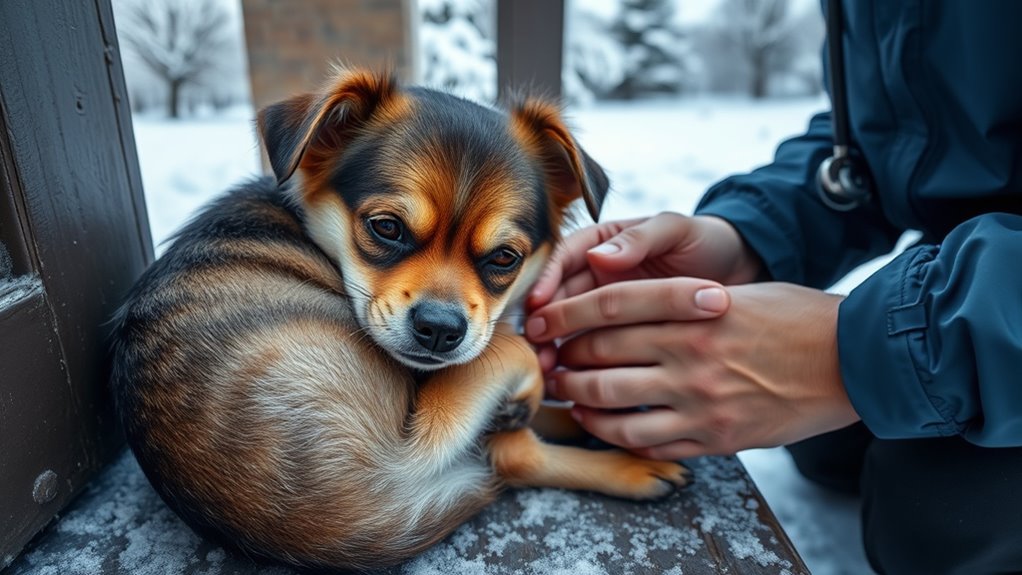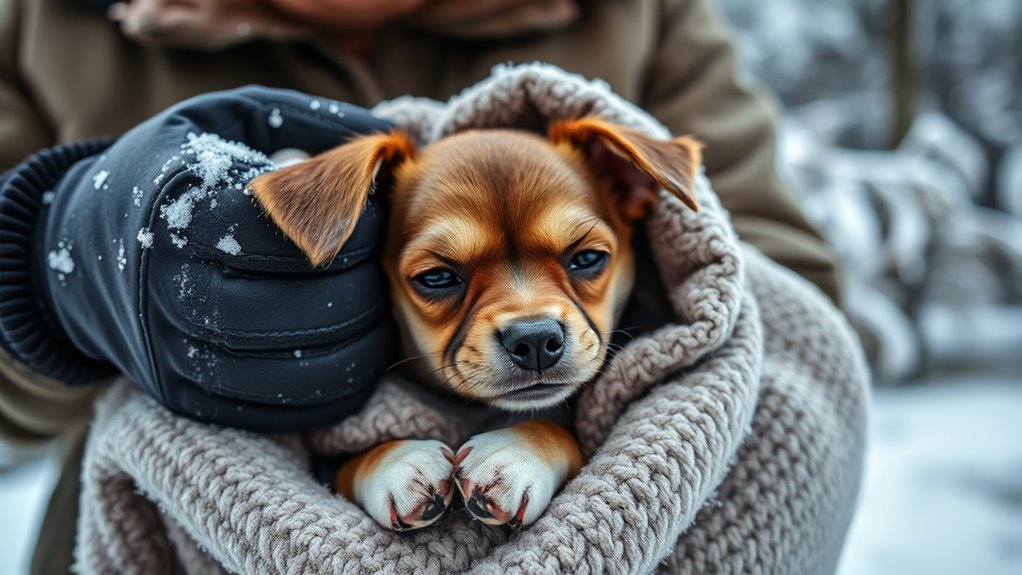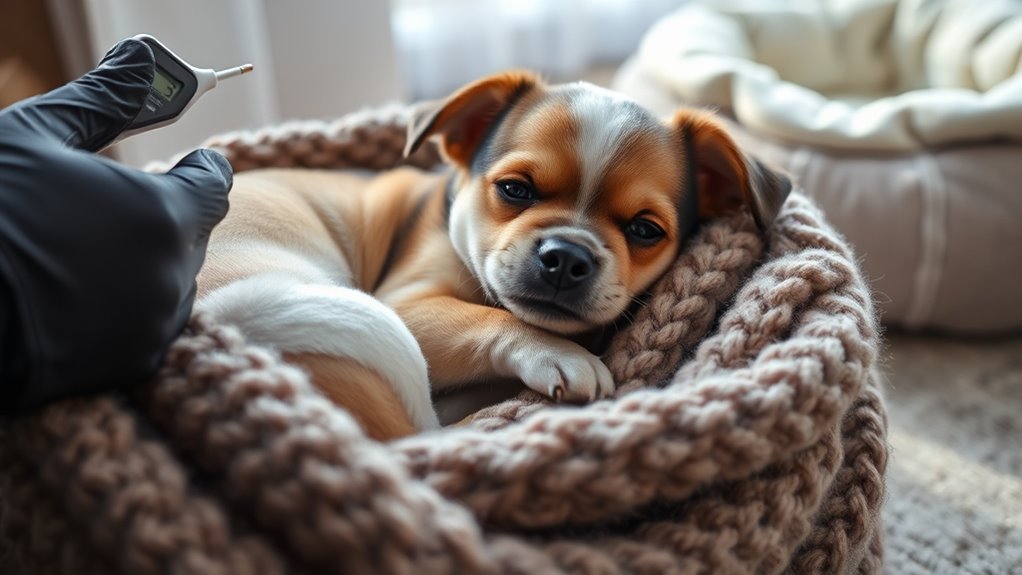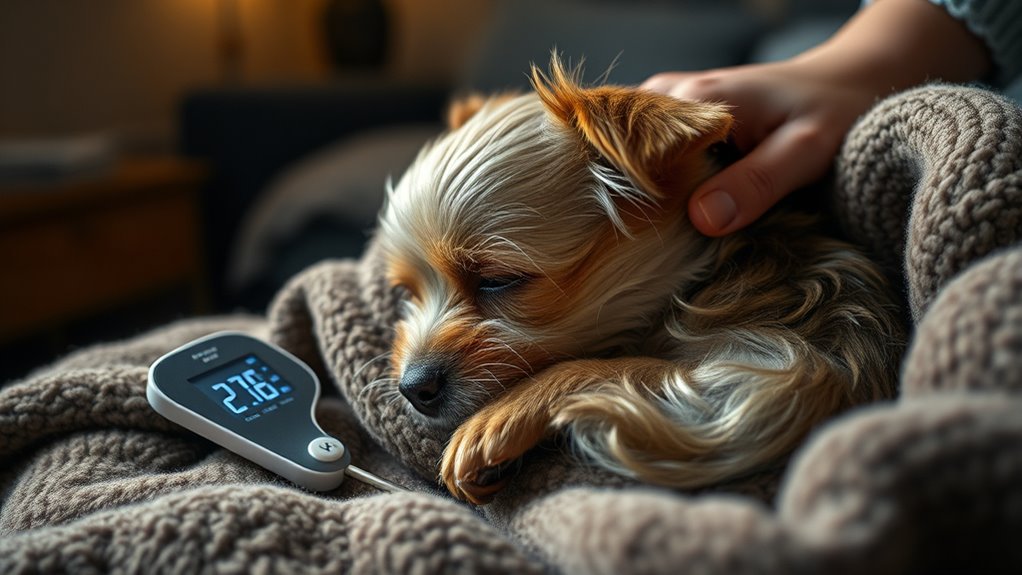If you suspect your pet has hypothermia, look for signs like shivering, sluggishness, cold paws or ears, and disorientation. To treat, gently move your pet to a warm, dry spot, and use blankets or warm water bottles on core areas—avoid direct heat like hairdryers. Keep a close eye on their response, and seek veterinary care if symptoms worsen. Continue exploring ways to protect and care for your furry friend during cold weather.
Key Takeaways
- Recognize hypothermia signs such as shivering, lethargy, cold extremities, and disorientation in pets.
- Gently move the pet to a warm, dry environment and insulate using blankets or towels.
- Use warm objects like water bottles wrapped in cloth on core areas, avoiding direct heat sources.
- Avoid feeding or giving water until the pet stabilizes; monitor breathing and responsiveness closely.
- Seek veterinary help immediately if symptoms persist, worsen, or if the pet shows signs of severe cold distress.
Signs and Symptoms of Hypothermia in Pets

Recognizing hypothermia in pets is crucial because early detection can prevent serious complications. When your pet’s body temperature drops below normal, you might notice they become shivering, restless, or anxious. They may also appear lethargic or weak, struggling to move comfortably. Cold extremities, like paws, ears, and tail, can turn pale or bluish, indicating poor circulation. You might see their muscles trembling or their breathing slowing down. In advanced cases, your pet could seem disoriented, unresponsive, or exhibit low heart rate. These signs are important clues that your pet is struggling to maintain body heat. Staying alert to these symptoms helps you act quickly and seek the right help to prevent further health issues. Automation technologies are also being utilized in veterinary care to monitor and manage pets’ health more effectively.
Immediate Actions to Take if You Suspect Hypothermia

If you suspect your pet has hypothermia, acting quickly can make all the difference. First, gently move your pet to a warm, dry area away from cold drafts. Check their breathing and heart rate, and avoid handling them roughly. Use a clean towel or blanket to wrap your pet, focusing on core areas like the chest and abdomen. Do not attempt to give them food or water until they’re stabilized.
Remember:
- Prioritize a warm, draft-free environment to prevent further cooling
- Handle your pet gently to avoid stress or injury
- Monitor their breathing and responsiveness closely
- Understanding hypothermia symptoms can help you recognize the signs early and respond appropriately
Taking these steps can stabilize your pet until you can get professional help. Quick, calm action can save their life.
How to Safely Warm Your Pet

To warm your pet safely, start by gradually increasing their body temperature with gentle methods. Begin by moving your pet to a warm, draft-free environment. Use soft blankets or towels to gently wrap them, providing insulation without causing discomfort. You can also apply warm (not hot) water bottles or heating pads wrapped in a cloth to areas like the armpits, groin, or chest—these sites help transfer heat effectively. Never use direct heat sources like a hairdryer or hot water, as they can burn your pet’s skin or cause shock. Monitor their response closely, and stop warming immediately if they show signs of distress. The goal is to raise their temperature slowly, ensuring they stay comfortable and avoid further stress. Incorporating Glycolic Acid in your pet’s skincare routines may improve skin health and aid in recovery once their body temperature stabilizes.
Preventive Measures to Protect Your Pet During Cold Weather

During cold weather, taking proactive steps can considerably reduce the risk of hypothermia and other cold-related health issues for your pet. Ensure your pet has access to a warm, dry shelter that shields them from wind and rain. Dress your pet in appropriate clothing if they have short fur or are small, to help retain body heat. Limit outdoor activities during extreme cold, and always supervise your pet outside. Consider these preventive measures:
- Provide insulated bedding to maintain warmth during rest.
- Keep outdoor areas free of snow and ice, which can cause cold stress.
- Regularly check your pet for signs of cold discomfort or frostbite.
- Be aware of the impact of clothing on heat retention to further protect your pet from the cold.
Implementing these precautions helps keep your pet safe and comfortable in winter conditions.
When to Seek Veterinary Assistance

While preventive measures greatly reduce the risk of hypothermia, it’s important to recognize when your pet might need professional help. If your pet shows signs like extreme shivering, lethargy, weakness, or difficulty breathing, seek veterinary assistance immediately. Do not wait for symptoms to worsen, as hypothermia can become life-threatening quickly. Keep a close eye on their behavior and physical condition, especially in very cold weather. Use the table below to determine when prompt vet care is necessary:
| Signs to Watch For | Action Needed |
|---|---|
| Persistent shivering | Seek veterinary help immediately |
| Lethargy or unconsciousness | Get help without delay |
| Cold, pale, or bluish gums | Urgent veterinary attention |
| Difficulty walking or coordination | Immediate vet consultation |
| Rapid or irregular breathing | Contact vet urgently |
Additionally, being aware of the signs of hypothermia can help in early detection and prompt intervention.
Frequently Asked Questions
Can Certain Breeds Be More Prone to Hypothermia?
Yes, certain breeds are more prone to hypothermia. Small, short-haired, or thin-coated breeds like Chihuahuas, Greyhounds, and Whippets struggle to retain body heat in cold weather. Brachycephalic breeds such as Bulldogs and Pugs also have trouble breathing and warming up. If you own these breeds, you need to be extra cautious during cold weather, providing warm shelter, clothing, and limiting outdoor exposure to prevent hypothermia.
How Long Does It Typically Take to Rewarm a Hypothermic Pet?
It usually takes about 30 minutes to a few hours to rewarm a hypothermic pet, depending on severity. You should start by gently warming them with blankets, warm water bottles, or heating pads, but avoid direct heat. Keep them in a warm, quiet environment and monitor their temperature closely. If they don’t improve or if their condition worsens, seek veterinary care immediately to prevent complications.
Are There Home Remedies That Could Worsen a Pet’s Condition?
Have you ever wondered if home remedies could harm your pet? Yes, some can. Applying direct heat like hot water or heating pads might cause burns or shock, especially if your pet is severely hypothermic. Never give your pet alcohol, caffeine, or medications meant for humans. Instead, focus on keeping them warm with blankets and seek emergency vet care promptly. Your pet’s safety depends on knowing what not to do.
What Long-Term Effects Can Hypothermia Have on Pets?
If hypothermia isn’t treated, it can cause long-term damage to your pet’s organs, including the heart and kidneys. You might notice ongoing weakness, poor coat health, or behavioral changes. In severe cases, it can lead to permanent tissue damage or even death. To protect your pet, seek prompt veterinary care if you suspect hypothermia, and follow their advice to minimize lasting effects.
How Can I Tell if My Pet Is Recovering From Hypothermia?
You’ll know your pet’s recovering when they start acting more like themselves, wagging tails or purring with enthusiasm. Watch for warmth returning—fingers or ears feeling less cold to the touch—and improved alertness. Their breathing should normalize, and they’ll be keenly seek food or water again. If their color brightens and energy levels rise, congratulations! They’re bouncing back from hypothermia, proving your quick action made all the difference.
Conclusion
By staying vigilant and acting quickly, you become the guardian of your pet’s warmth and safety, guiding them through the icy storm of hypothermia. Think of yourself as a lighthouse, shining a steady beam to lead your furry friend back to comfort and health. Remember, recognizing the signs and taking prompt action can turn a potentially dangerous situation into a moment of rescue. With love and care, you can help your pet weather any cold snap.










